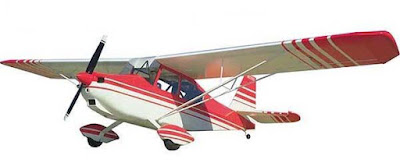Photos taken probably spring 1986
The kit ( RC-28 ) was designed by Hank Pohlmann around 1971 as a replacement for Maxey Hester's Midget 450 ( RC-6 ). It was powered by a Picco 45 with a Perry carb. As my dad tells the story, he built the plane on the ship he was working on and flew it as a guest at Sault Ste Marie. He didn't like the control throws on the aileron, so he doubled them. The plane had never flown and this was to be the test flight. As the plane took off, a wing started to drop, as they always do when they're slightly out of trim. The roll rate was so fast that the plane did a complete 360 degree roll before anyone knew what was happening. Dad pulled up on the elevator and was lucky the plane was right side up. Everyone thought he was some hot shot pilot when really it was the luck of the Irish!
Hank and the Mustang were on the cover of Model Airplane News
After I got my wings, and was flying the Blue Max, dad would let me fly the Mustang a little bit. It scared the hell out of me. It was snappy and I was afraid of stalling it on landing, which was way too fast for my liking at the time. It did crash a few times, but that foam wing never broke! Many years later, I've aquired a kit and will finish building it. I'm undecided on an engine, since the Picco 45 is no longer available. Maybe I'll put a period K&B in it or something ( Oh, the horror! ).
Plans are available on the Outerzone















